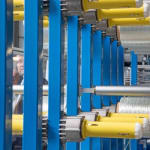 Composite materials are light, extremely robust, and offer a wide range of design options. Although they are an essential part of modern production – for example when it comes to lighter cars or high-performance wind power plants –, production at the industrial scale has so far been hampered by complex and costly processes. This may now change. Evonik assigned an interdisciplinary team to search for solutions for a three-year term in its Composites Project House. The recently completed project house came up with materials and processes that enable automated production at economical prices. Potential customers in a variety of industry sectors are already testing the developments.
Composite materials are light, extremely robust, and offer a wide range of design options. Although they are an essential part of modern production – for example when it comes to lighter cars or high-performance wind power plants –, production at the industrial scale has so far been hampered by complex and costly processes. This may now change. Evonik assigned an interdisciplinary team to search for solutions for a three-year term in its Composites Project House. The recently completed project house came up with materials and processes that enable automated production at economical prices. Potential customers in a variety of industry sectors are already testing the developments."The new developments from the Composites Project House are a perfect fit for our extensive product portfolio that addresses all essential components of composite materials," said Dr. Gerd Löhden, head of Innovation Management in the Resource Efficiency Segment, which will take over seven of the nine developments for product expansion. "We are well on our way to overcome the challenges of the industry together with our customers."
With this step, Evonik is positioning itself for the long term in the growing composites market, while also providing fresh impulses. The global composites market reached a volume of approx. €74 billion and about 9 million metric tons in 2015, with further growth projected. Experts forecast a growth rate of six percent annually for the years to come (Source: JEC Composites). This growth is driven primarily by the aerospace, wind energy, sports and leisure, and oil and gas extraction industries.
Moreover, the solutions developed by the Project House will also offer new options for the automotive industry, which increasingly relies on composite materials to reduce vehicle weight and CO2 emissions. "Due to their high cost, composites have primarily been used in the premium segment so far," explains Dr. Sandra Reemers, who led the Project House until the end of its term in the spring of 2016. The newly invented PulPress procedure, which allows for the economical, fully automated production of complex molded parts, may provide a solution. "In comparison with identical parts made of steel, the weight can be reduced by up to 75 percent, and the cost per unit decreases by 30 to 60 percent compared to other manufacturing processes for composites."
A new material system solution for the first step in the production of composites – the production of pre-impregnated fibers (prepregs) – also aimed at greater efficiency. The newly developed thermally controllable hybrid polymers combine quick and easy processing with ultra-high stress resistance–properties that were previously considered incompatible. Significant progress was also achieved in the surface quality of composite materials as well as for the production of flame-retardant prepregs and unidirectional tapes, the thin synthetic strips embedded in parallel in endless reinforcement fibers. In addition, the Project House came up with a process that allows for combining metals and fiber-reinforced polymers in composite materials.
When the term of the project house ended, the new materials and system solutions were integrated into the Resource Efficiency and Performance Materials segments. "This highlights again the valuable contributions of the project house concept to building new competencies," noted Dr. Ulrich Küsthardt, chief innovation officer of the specialty chemicals group. Project houses at Evonik, which bring together professional knowledge from several operating units along the entire value chain and supplement it with external expertise, have generated new ideas for fifteen years. Up to twenty employees engage in interdisciplinary research of strategically relevant topics without organizational boundaries. The Composites Project House was the tenth version of this innovation approach.


